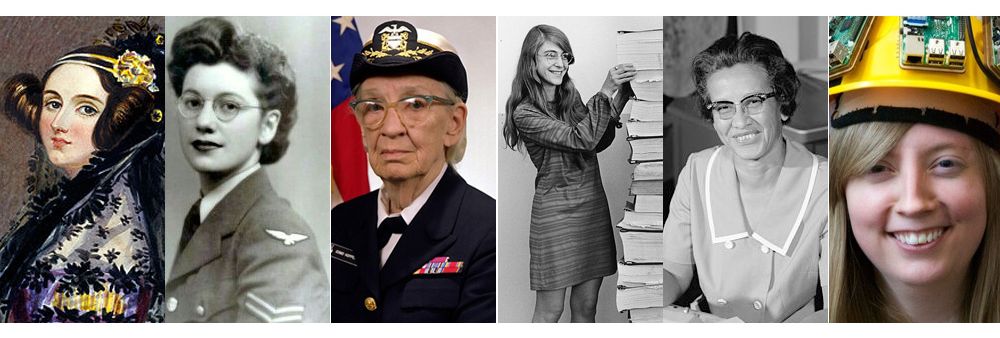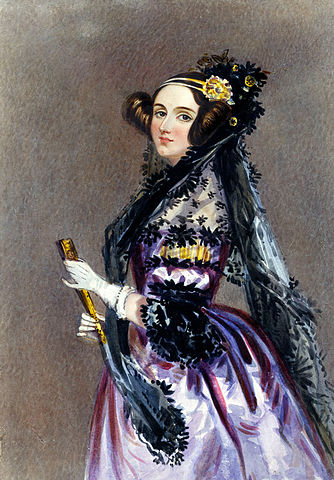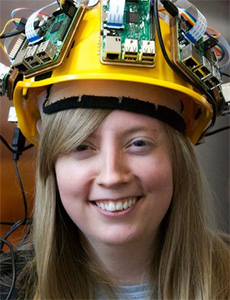
Heroes of code
Written by Kat
Although we ♥ technology, we also love to learn about the people behind it.
Many incredible people have contributed to the computers that we use today. We have many coding heroes, this is a selection of just a few women who inspire us. Let us know if there's someone else who would be on your list.
Ada Lovelace

Augusta Ada King-Noel (what a mouthful!), Countess of Lovelace née Byron, had one of those lives that sounds stranger than fiction.
She was the only legitimate child of the flamboyant and notorious poet, Lord Byron, who separated from Ada's mother, Anabella, just a month after Ada's birth in 1815.
Ada's mother harboured a life-long bitterness towards her husband, Lord Byron. She campaigned against him obsessively and would not permit Ada to even see a portrait of him until she was 20 years old. Anabella believed Byron was mad, possibly as a result of his love for the arts, and to avoid a similar fate for her daughter she made sure that Ada's education was rooted in mathematics and logic.
Ada grew up surrounded by scientists and inventors. Despite her mother's meddling, she became interested in both arts and sciences, describing her approach as "poetical science". Her tutor was Mary Sommerville, a Scottish scientist and mathematician. As a teenager she was introduced to Charles Babbage and she developed a working relationship with him.
Charles Babbage is known as the father of computers for developing the Analytical Engine, a mechanical general-purpose computer. Ada wrote an algorithm designed to be carried out by the machine, and for this reason she is considered by some to be the first computer programmer.
While Charles Babbage focussed on the calculations that his Analytical Engine could perform, Ada had a grander vision. She imagined computers carrying out tasks beyond calculation and was interested in the relationship between individuals, society and technology.
Tragically she died of cancer in 1852 at the age of 36, the same age as her father who had died in 1824. Despite their separation and her mother's hatred of him, Ada chose to be buried next to Lord Byron in the Church of St Mary Magdalene, Hucknall.
Joan Clarke
![Joan Clarke By EduWiki (Own work) [CC BY-SA 4.0 (http://creativecommons.org/licenses/by-sa/4.0)], via Wikimedia Commons](/images/blog/heroes-of-code/Joan_Clarke.jpg) Joan Clarke was an excellent mathematician and cryptanalyst who worked as a code-breaker in Bletchley Park during World War II. Her story shows the frustrating gender imbalance that existed at the time.
Joan Clarke was an excellent mathematician and cryptanalyst who worked as a code-breaker in Bletchley Park during World War II. Her story shows the frustrating gender imbalance that existed at the time.
She gained a double-first in mathematics at Cambridge and her third-year exam results were amongst the top marks. However, Cambridge did not allow women to become full members of the university until 1948 so, despite her achievements, she was prevented from receiving a full degree.
She was recruited to the Government Code and Cypher School (GCCS) in 1940. At first, she was placed in an all-female group that did mainly clerical work, earning just £2 a week - significantly less than her male counterparts.
She was quickly promoted to work in Hut 8 with Alan Turing and other cryptographers, but there were no protocols in place for a senior female cryptanalyst so she was classed as a linguist in order to award her extra money, although she spoke no other languages.
Joan Clarke and Alan Turing spent a great deal of time together and were good friends right up until his death in 1954. They were briefly engaged, despite the fact that he admitted he was homosexual, but ultimately Turing decided he could not go through with the marriage. This relationship was depicted in the 2014 film The Imitation Game where Joan Clarke was played by Keira Knightley.
The impact of the code breakers on the outcome of World War II was enormous, significantly reducing shipping losses and saving thousands of lives. It is likely that the work of Bletchley Park shortened the war by a number of years. However, because of the secrecy that still surrounds the work of the cryptographers, the full extent of Clarke's achievements remains unknown.
Grace Hopper
![Grace Hopper By James S. Davis [Public domain], via Wikimedia Commons](/images/blog/heroes-of-code/Grace_Hopper.jpg)
Today's computer programmers have a lot to thank Grace Hopper for - unless binary is your preferred method of communication.
She inventing one of the first compilers: a tool that translates code written in a way that's easy for humans to understand into a more basic language for computers. She also promoted the idea of machine-independent programming languages.
Like Joan Clarke, Grace Hopper's computer science career began during World War II. She tried to enlist in the navy but at 34 was too old and below the minimum weight for her height. Her job as a mathematician and mathematics professor was also considered too valuable for the war effort, but in 1943 she got a leave of absence and joined the US Navy Reserve.
Her first assignment was to work on the Mark I computer at Harvard University. The Mark I was a general purpose electro-mechanical computer used in the final stages of World War II. One of its first programmes was for the Manhattan Project. It also computed and printed mathematical tables, just as Charles Babbage had planned for his Analytical Engine.
At the age of 38 Hopper tried once more to transfer to the regular Navy but was declined as being too old.
In 1949 she joined the team working on UNIVAC I, the first commercial large-scale electronic computer. She recommended that a new programming language was developed which used entirely English words instead of machine code. The idea was quickly rejected - Hopper says "they told me computers could only do arithmetic" - but she continued to develop the idea. In 1952 she had an operational compiler and published a paper on the subject. Like Ada Lovelace, Hopper was a computer science visionary.
Her ideas were the basis for COBOL, a high-level English-like programming language which was designed in 1959 and is still in use today. COBOL was one of the first programming languages that Kat learnt - she's that old!
Remember how Hopper tried to join the Navy twice but was turned down as being too old? In 1966 she retired from the Naval Reserve but the next year was recalled to active duty for a 6 month period which turned into an indefinite assignment. She finally retired in 1986 at the grand old age of 79, having been promoted to Rear Admiral and awarded the Defense Distinguished Service Medal, the highest non-combat decoration.
Margaret H. Hamilton
![Margaret Hamilton By Draper Laboratory; restored by Adam Cuerden [Public domain], via Wikimedia Commons](/images/blog/heroes-of-code/386px-Margaret_Hamilton_-_restoration.jpg) Margaret Hamilton was Director of the Software Engineering Division which developed the in-flight software for the Apollo space program (the photo shows her stood next to a print out of the code). Her systems, particularly error handling and priority scheduling of tasks, were crucial for the success of the moon landings and laid "the foundation for ultra-reliable software design."
Margaret Hamilton was Director of the Software Engineering Division which developed the in-flight software for the Apollo space program (the photo shows her stood next to a print out of the code). Her systems, particularly error handling and priority scheduling of tasks, were crucial for the success of the moon landings and laid "the foundation for ultra-reliable software design."
Hamilton studied mathematics at university then became an intern at MIT, working first on weather prediction and then on aircraft detection systems used during the Cold War.
To qualify as a candidate for the Apollo flight software, Hamilton was given the task assigned to all new starters: a complicated programme which nobody had ever managed to figure out. On top of the complicated code, its comments were written in Greek and Latin. Hamilton was the first person to get it to work, and even output its answers in Latin and Greek.
She joined to the MIT laboratory working on the Apollo space mission and eventually led the team responsible for developing in-flight software for Apollo and Skylab. This was a time when few computer science courses existed, so Hamilton had to gain hands-on experience. In fact, it was Hamilton who coined the term "software engineering".
During the Apollo 11 mission, computer alarms were triggered 3 minutes before the lunar lander reached the Moon's surface. The astronauts faced a go/no go decision whether to land or not. The guidance computer was not able to complete all of its tasks in real time and had to postpone some, but computer engineers at mission control recognised the meaning of the errors and shouted: "Go, go!"
Margaret Hamilton said "the software's action, in this case, was to eliminate lower priority tasks and re-establish the more important ones ... If the computer hadn't recognized this problem and taken recovery action, I doubt if Apollo 11 would have been the successful moon landing it was".
Katherine Johnson
![Katherine Johnson By NASA; restored by Adam Cuerden [Public domain], via Wikimedia Commons](/images/blog/heroes-of-code/Katherine_Johnson_at_NASA,_in_1966.jpg) Katherine Johnson is an African-American physicist and mathematician who calculated trajectories, launch windows, and emergency return paths for numerous NASA missions. If you've seen the 2016 film Hidden Figures, you will have seen her portrayed by Taraji P. Henson.
Katherine Johnson is an African-American physicist and mathematician who calculated trajectories, launch windows, and emergency return paths for numerous NASA missions. If you've seen the 2016 film Hidden Figures, you will have seen her portrayed by Taraji P. Henson.
Johnson was something of a child progeny, showing a talent for maths from a young age. Public school wasn't available for African-Americans beyond 8th grade (13 - 14 years) where she lived, so her parents arranged for her to attend a high school from the age of 10. She finished high school at 14, went to college where she took every maths course available (including some that were created just for her) and graduated at age 18.
Maths career options were limited to teaching for black women in the 1950s, but in 1953 she was able to join the Guidance and Navigation Department of the National Advisory Committee for Aeronautics (NACA). Like many other women, she worked as a human computer, performing precise mathematical calculations on paper and slide rules. A temporary assignment allowed her to show off her abilities so that her bosses "forgot to return me to the pool".
Like all federal workplaces, NACA was segregated although Johnson says "I knew it was there, but I didn't feel it." In contrast, NASA (which replaced NACA in 1958) was desegregated. However, Johnson still had to battle to get recognition: "In the early days of NASA women were not allowed to put their names on the reports."
Johnson worked as an aerospace technologist until her retirement in 1986. When Alan Shepard became the first American in space in 1961, Johnson calculated the trajectory of his space flight. When John Glenn became the first American to orbit the Earth, circling it three times, NASA used electronic computers to perform the calculations for the first time. Glenn asked specifically for Johnson to verify the computer's numbers and refused to fly unless she verified the calculations.
Johnson was not the only African-American woman working at NASA. Mary Jackson was NASA's first black female engineer in 1958. Dorothy Vaughan taught herself and her staff FORTRAN to prepare for the introduction of machine computers; she later headed the programming section of the Analysis and Computation Division (ACD) at Langley. Countless women worked as human computers and early programmers behind the scenes, totally unrecognised, but essential for the US space programme.
Carrie Anne Philbin
 ... which brings us up to the present day!
... which brings us up to the present day!
We discovered Carrie Anne Philbin watching the YouTube Crash Course series on Computer Science. We're big fans of Crash Course, one of the PBSD channels.
Carrie Annie is an award-winning secondary school Computing & ICT teacher, YouTuber with her own channel called Geek Gurl Diaries, Director of Education for the Raspberry Pi Foundation and author of a coding book for teenagers: Adventures In Raspberry Pi.
She's an evangelist for programming, computer science, electronics and generally geeking out. She describes what motivated her to start her Geek Gurl Diaries: "I noticed that the uptake of ICT and Computer Science by teenage girls at KS4, KS5 [age 14-17] and higher education was also just as limited, and that female students would opt for subjects which are seen as more creative such as Art, Dance, or Humanities. As a woman in tech myself I started to think about what I could do to improve the status quo. What was it about science, technology and computer science that excited me, and how could I get that across to young people?"
We think Miss P's students are lucky to have her as a teacher. Not only is she highly qualified - she's a Google Certified Teacher and KS3 ICT Subject Leader - but she's passionate and makes the subject interesting and fun. "I have a blended and open approach to teaching... I use innovative web tools to help support and extend the learning in my 21st century classroom."
Keep up the good work Carrie Anne, we'll keep watching!
Who will be the future heroes of code?
We need more people working in technology overall and more women in particular. They account for only 9% of all engineering and technology employees in the UK (according to a 2015 survey by the Institute of Engineering and Technology), of which 15% work in Computing and IT. Pretty much every industry has a technological side these days, and every imaginable type of job is available - it's not just about writing code (although coding is awesome). Perhaps more than ever we need visionaries like Ada Lovelace who look at the way we use technology now and imagine how our lives and our world could be improved in future.
Tagged under: Hot topics Fun